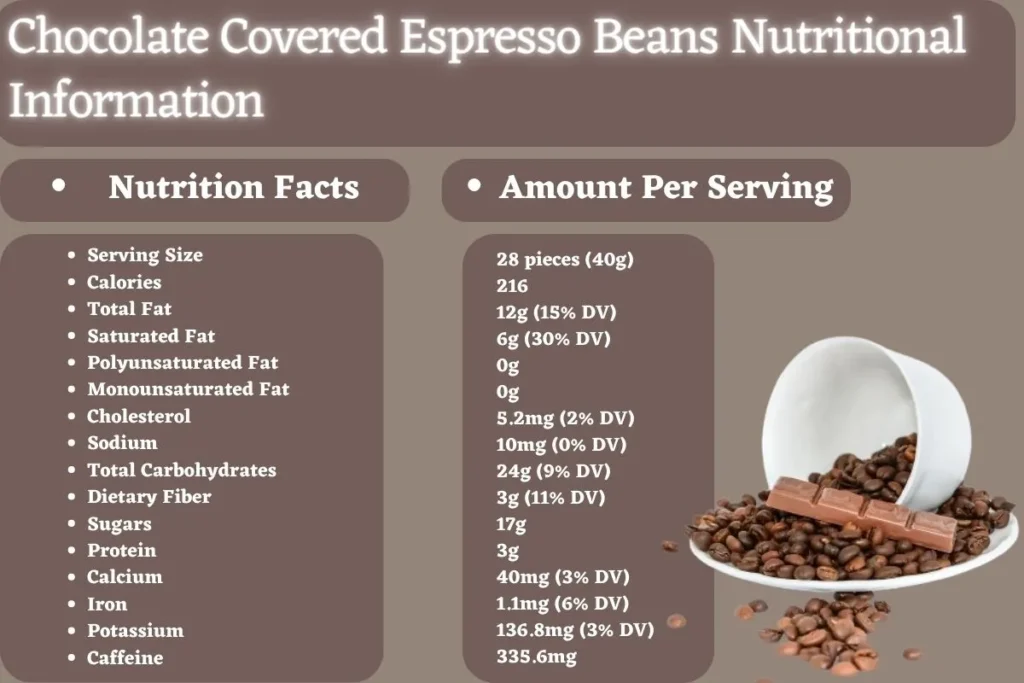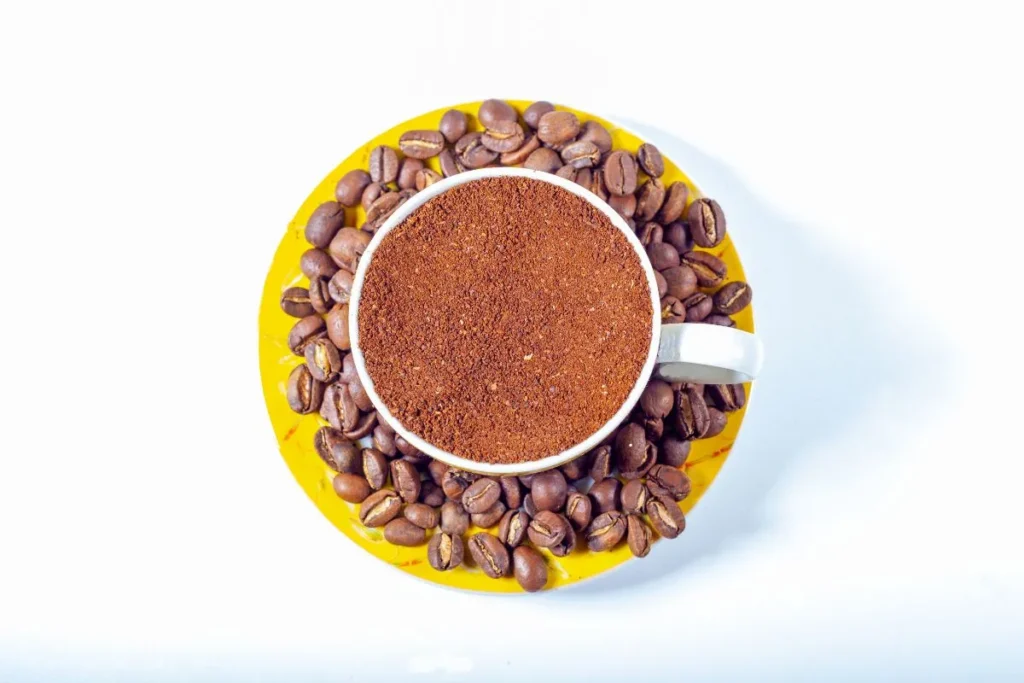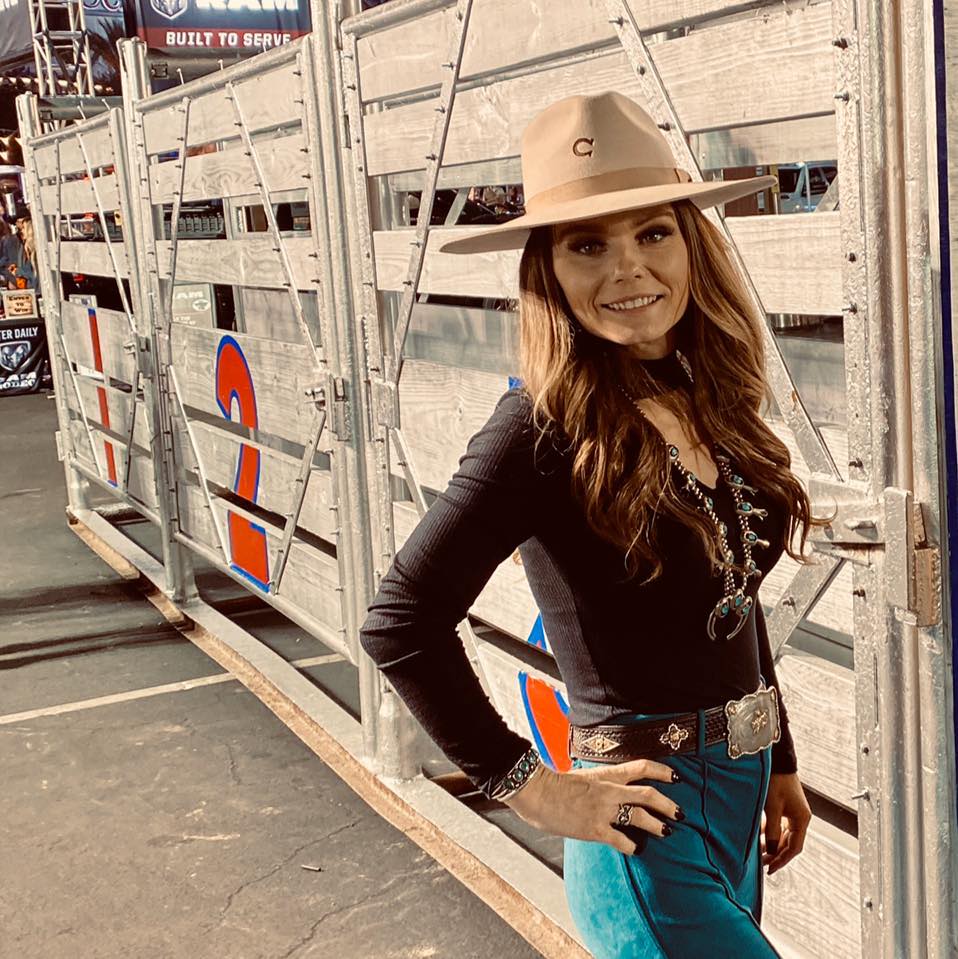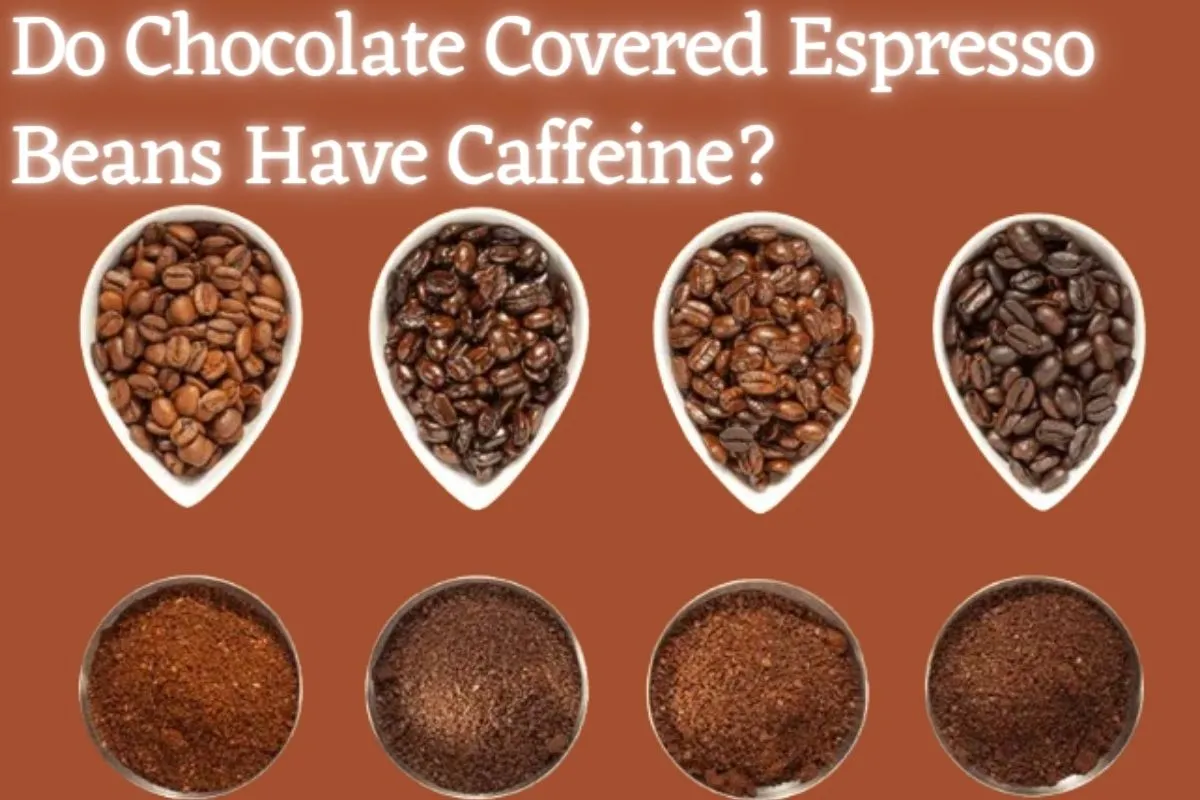Have you ever craved that afternoon energy boost but wanted something a little more exciting than your usual cup of coffee? Chocolate-covered espresso beans might be the answer! These delightful treats combine the rich, roasted flavor of espresso with the sweetness of chocolate.
But before you indulge, you might be wondering – do they pack the same caffeine punch as your morning brew?
Let’s dive in and find out Do Chocolate Covered Espresso Beans Have Caffeine?
Importance of Knowing Caffeine Content in Chocolate Covered Espresso Beans
Chocolate-covered espresso beans are a popular snack enjoyed worldwide, offering a quick burst of energy and a satisfying flavor combination. While they might seem like a harmless indulgence, understanding their caffeine content is crucial.
Knowing the caffeine levels helps consumers enjoy the benefits of a moderate caffeine boost, like increased alertness and focus, while potentially avoiding some of the downsides associated with excessive intake.
Factors like the type of bean (Arabica vs. Robusta), the amount of chocolate coating, and serving size all affect total caffeine content. There’s a common misconception that caffeine comes mainly from the chocolate, when in reality, the espresso bean is the primary source.
It’s important to be aware that those who are sensitive to caffeine, pregnant or breastfeeding women, and children should limit or avoid chocolate-covered espresso beans altogether. Their potential for causing jitters, sleep disturbances, or anxiety can outweigh the benefits for these groups.
Do Chocolate Covered Espresso Beans Have Caffeine?
Yes, chocolate-covered espresso beans do contain caffeine. The caffeine content in chocolate-covered espresso beans can vary depending on the brand and size of the beans, but on average, each bean contains around 5-10 milligrams of caffeine.
Consuming these beans can provide a quick energy boost and improve mental alertness due to the combination of caffeine and sugar from the chocolate. It’s important to enjoy these treats in moderation, as overconsumption of caffeine can lead to negative effects like insomnia, nervousness, and an increased heart rate.
Several factors influence the caffeine content in chocolate-covered espresso beans.
- Firstly, the type of coffee bean used plays a significant role. Dark roast coffee beans generally contain more caffeine than lighter roasts, with a dark roast bean typically having around 10-12 milligrams of caffeine.
- Secondly, the type of chocolate used in the coating affects the overall caffeine content. Dark chocolate has a higher caffeine content compared to milk or white chocolate, with dark chocolate covered espresso beans containing approximately 11-14 milligrams of caffeine per bean.
- Additionally, the method of consumption impacts how efficiently the caffeine is absorbed. Eating espresso beans whole leads to faster absorption of caffeine through the lining of the mouth, delivering a more concentrated and quicker-acting dose of caffeine compared to brewed coffee. This rapid absorption can intensify both the positive and negative effects of caffeine, making moderation important to avoid adverse health effects.
Chocolate Covered Espresso Beans Variants and their Caffeine Content
There are several variants of chocolate covered espresso beans available, offering a range of flavors and options to suit different preferences.
Dark Chocolate Covered Espresso Beans
These boast the most intense flavor profile. The bittersweet nature of dark chocolate offers a beautiful contrast to the bold, roasted flavor of the espresso bean. Expect the highest caffeine content in this variety, typically ranging from 5-12 mg per bean.
Milk Chocolate Covered Espresso Beans
For those preferring a sweeter experience, milk chocolate provides a creamier, less bitter flavor. The caffeine content is slightly lower compared to the dark chocolate variety, usually around 5-10 mg per bean.
White Chocolate Covered Espresso Beans
This type offers a predominantly sweet and milky flavor profile. While the caffeine content remains similar to other varieties (5-10 mg per bean), the strong sweetness of white chocolate can partially mask the espresso bean’s flavor.
Flavored Chocolate
Get creative with chocolate infused with flavors beyond the basics! Think mint chocolate, orange-infused chocolate, or even peanut butter chocolate for a unique twist. Caffeine content in these likely remains similar to the traditional varieties.
Assorted Flavors
Exciting variety packs offer a mix of dark, milk, white, or even flavored chocolate coatings, providing a delightful sampler experience!
Organic and Vegan Options
For those with dietary preferences, it’s good to know that brands catering to organic and vegan lifestyles often produce chocolate-covered espresso beans as well. Look for beans made with organic ingredients and vegan-friendly dark chocolate.
Decaffeinated Varieties
If you enjoy the flavor but want to minimize caffeine intake, some brands offer espresso beans that have undergone a decaffeination process.
Custom Blends
Specialty shops or online retailers might allow you to personalize your chocolate-covered espresso bean experience. Choose your preferred bean type, roast level, chocolate type, and even potential flavor additions!
List of Ingredients in Chocolate Covered Espresso Beans
The following components go into making chocolate-covered espresso beans:
- Espresso Beans: Whole roasted espresso beans are the star of the show! The variety of bean matters – Robusta beans typically contain more caffeine than Arabica beans. You might find different roast levels for the beans, ranging from light to dark, offering variations in flavor intensity.
- Chocolate: The type of chocolate significantly impacts flavor and potential sweetness. Dark chocolate, with its higher cocoa content, provides a robust, slightly bitter counterpoint to the espresso. Milk chocolate offers a creamier, sweeter experience. White chocolate, while less common, adds a milky sweetness.
- Coconut Oil: A small amount of coconut oil might be added to the chocolate, creating a smoother texture for dipping and a more even coating.
- Flavorings: Extracts like vanilla, peppermint, or a touch of orange zest can be incorporated into the chocolate, adding a layer of flavor complexity.
- Cocoa Powder: Finished beans may be lightly dusted with unsweetened cocoa powder for a slightly bitter finish and a decorative touch.
- Spices: A pinch of cinnamon, chili powder, or even a hint of cardamom mixed into the chocolate can create an exciting and unique flavor profile.
- Other Coatings: While not traditional, sometimes the beans are coated in yogurt or flavored candy coatings instead of chocolate, offering a whole new twist.
Chocolate Covered Espresso Beans Nutritional Information

A typical serving of dark chocolate-covered coffee beans (approximately 28 pieces or 40g) contains 216 calories. In terms of macronutrients, you’ll find 12g of total fat (15% DV), with 6g of that being saturated fat (30% DV).
There’s very little sodium (10mg) and a moderate amount of carbohydrates at 24g (9% DV) – of which 3g is dietary fiber (11% DV) and 17g is sugar. You’ll also get a small amount of protein (3g) and some minerals like calcium (40mg, 3% DV) and iron (1.1mg, 6% DV).
One important thing to note is that a serving of dark chocolate-covered coffee beans contains a significant amount of caffeine, around 335.6mg.
| Nutrition Facts | Amount Per Serving |
| Serving Size | 28 pieces (40g) |
| Calories | 216 |
| Total Fat | 12g (15% DV) |
| Saturated Fat | 6g (30% DV) |
| Polyunsaturated Fat | 0g |
| Monounsaturated Fat | 0g |
| Cholesterol | 5.2mg (2% DV) |
| Sodium | 10mg (0% DV) |
| Total Carbohydrates | 24g (9% DV) |
| Dietary Fiber | 3g (11% DV) |
| Sugars | 17g |
| Protein | 3g |
| Calcium | 40mg (3% DV) |
| Iron | 1.1mg (6% DV) |
| Potassium | 136.8mg (3% DV) |
| Caffeine | 335.6mg |
Alternatives to Chocolate-Covered Espresso Beans and their Caffeine Content
There are several alternatives to chocolate covered espresso beans available. These alternatives offer a diverse range of flavors and textures while delivering a similar caffeine boost to traditional chocolate-covered espresso beans.
Dark Chocolate-Covered Coffee Beans:
These beans are a popular choice for coffee lovers. Dark chocolate provides antioxidants while coffee beans offer a caffeine kick. On average, a 1 oz pack contains around 150mg of caffeine.
Mocha Chocolate-Covered Espresso Beans:
The combination of chocolate and espresso beans creates a rich and indulgent treat. With a caffeine content similar to dark chocolate-covered coffee beans, about 150mg per 1 oz pack.
Hazelnut Chocolate-Covered Coffee Beans:
Adding a nutty flavor to the mix, hazelnut chocolate-covered coffee beans offer the same caffeine content as traditional dark chocolate-covered coffee beans, around 150mg per 1 oz pack.
Sea Salt Dark Chocolate-Covered Espresso Beans:
The contrast of sea salt with dark chocolate and espresso beans creates a unique flavor profile. These beans also contain approximately 150mg of caffeine per 1 oz pack.
Vegan Dark Chocolate-Covered Coffee Beans:
Catering to plant-based diets, these beans provide the same caffeine content as their non-vegan counterparts, around 150mg per 1 oz pack.
Almond Dark Chocolate-Covered Espresso Beans:
The addition of almonds adds a crunchy texture to the creamy chocolate and bold coffee flavors. These beans also contain around 150mg of caffeine per 1 oz pack.
Salted Chickpea Dark Chocolate-Covered Coffee Beans:
A unique twist on the classic treat, the combination of chickpeas, dark chocolate, and coffee beans offers a savory-sweet experience with approximately 150mg of caffeine per 1 oz pack.
Dark Chocolate-Covered Coffee Beans with Different Roasts:
Beans with varying roasts, such as medium-dark or dark, provide a range of flavor profiles while maintaining a consistent caffeine content of about 150mg per 1 oz pack.
Flavored Dark Chocolate-Covered Espresso Beans:
Flavored varieties like mint or caramel add an extra dimension to the taste experience without altering the caffeine content, which remains around 150mg per 1 oz pack.
Bulk Dark Chocolate-Covered Coffee Beans:
Buying in bulk ensures a steady supply of caffeine. A 1 lb pack contains the equivalent of 16 servings of coffee, with each serving providing around 150mg of caffeine per 1 oz pack.
| Alternative | Caffeine Content |
| Dark Chocolate-Covered Coffee Beans | 150mg per 1 oz pack |
| Mocha Chocolate-Covered Espresso Beans | 150mg per 1 oz pack |
| Hazelnut Chocolate-Covered Coffee Beans | 150mg per 1 oz pack |
| Sea Salt Dark Chocolate-Covered Espresso Beans | 150mg per 1 oz pack |
| Vegan Dark Chocolate-Covered Coffee Beans | 150mg per 1 oz pack |
| Almond Dark Chocolate-Covered Espresso Beans | 150mg per 1 oz pack |
| Salted Chickpea Dark Chocolate-Covered Coffee Beans | 150mg per 1 oz pack |
| Dark Chocolate-Covered Coffee Beans with Different Roasts | 150mg per 1 oz pack |
| Flavored Dark Chocolate-Covered Espresso Beans (e.g., mint, caramel) | 150mg per 1 oz pack |
| Bulk Dark Chocolate-Covered Coffee Beans | 150mg per serving, 16 servings per 1 lb pack |
Recommended Daily Intake of Chocolate Covered Espresso Beans

Do Chocolate Covered Espresso Beans Have Caffeine? A serving of chocolate-covered espresso beans (28 pieces or 40g) contains a substantial 335.6mg of caffeine. To put this in perspective, the recommended daily intake (RDI) of caffeine for healthy adults, as set by the FDA, is 400mg.
This means a single serving of chocolate-covered espresso beans provides about 84% of the daily recommended caffeine intake. It’s important to be mindful of your caffeine consumption throughout the day, especially if you’re sensitive to its effects, to avoid potential side effects like jitters, anxiety, or sleep disturbances.
Conclusion
Do Chocolate-Covered Espresso Beans Have Caffeine? Yes, Chocolate-covered espresso beans most definitely contain caffeine! While the exact amount can vary slightly based on bean type, chocolate variety, and serving size, they offer a significant caffeine boost. If you’re looking for a tasty treat with an extra energy kick, these confections might be a good choice.
However, it’s essential to remember that they’re not a substitute for a balanced diet or a healthy sleep routine. Enjoy chocolate-covered espresso beans in moderation, and always be mindful of your overall daily caffeine intake, especially if you’re sensitive to caffeine’s effects.
Frequently Asked Questions
Q1. What are chocolate-covered espresso beans?
These delightful confections are made by taking whole, roasted espresso beans and enrobing them in a layer of chocolate. The chocolate is typically dark or milk chocolate, but sometimes even white chocolate is used. They deliver a satisfying combination of textures and flavors – the bold, slightly bitter notes of the coffee bean, the sweetness and richness of the chocolate, and a delightful crunch!
Q2. Do chocolate-covered espresso beans taste like regular coffee?
They retain the essence of roasted coffee but with a unique twist. The chocolate adds sweetness, softening the inherent bitterness of the espresso bean and creating a more balanced flavor profile. Consider it a coffee flavored treat rather than a straight coffee substitute.
Q3. How many chocolate-covered espresso beans equal one coffee?
It’s hard to make a direct comparison. While the caffeine content of roughly 7-10 beans might be similar to an 8 oz cup of coffee, the way your body absorbs and responds to caffeine is different. Coffee delivers a more gradual, sustained release of caffeine into your system, whereas espresso beans give you a quicker, more concentrated dose.
Q4. Can you get a buzz from chocolate-covered espresso beans?
Absolutely! That’s one of the main reasons people enjoy them. The espresso bean provides a significant caffeine boost, leading to increased alertness and focus. Just remember that the amount of caffeine varies depending on the serving size and the type of bean used, so be mindful of your intake.
Q5. Is it OK to eat espresso beans?
Espresso beans are safe to eat, either on their own or as part of a confection like chocolate-covered variations. However, due to their intense, concentrated flavor and high caffeine content, it’s definitely best to enjoy them in moderation.

Rossi Glover, the passionate Owner of Grand Lake Coffee, infuses every cup with her love for coffee and dedication to quality. With an extensive background in the art and science of coffee, Rossi is not just a connoisseur but a storyteller, sharing the intricate tales behind each brew.

